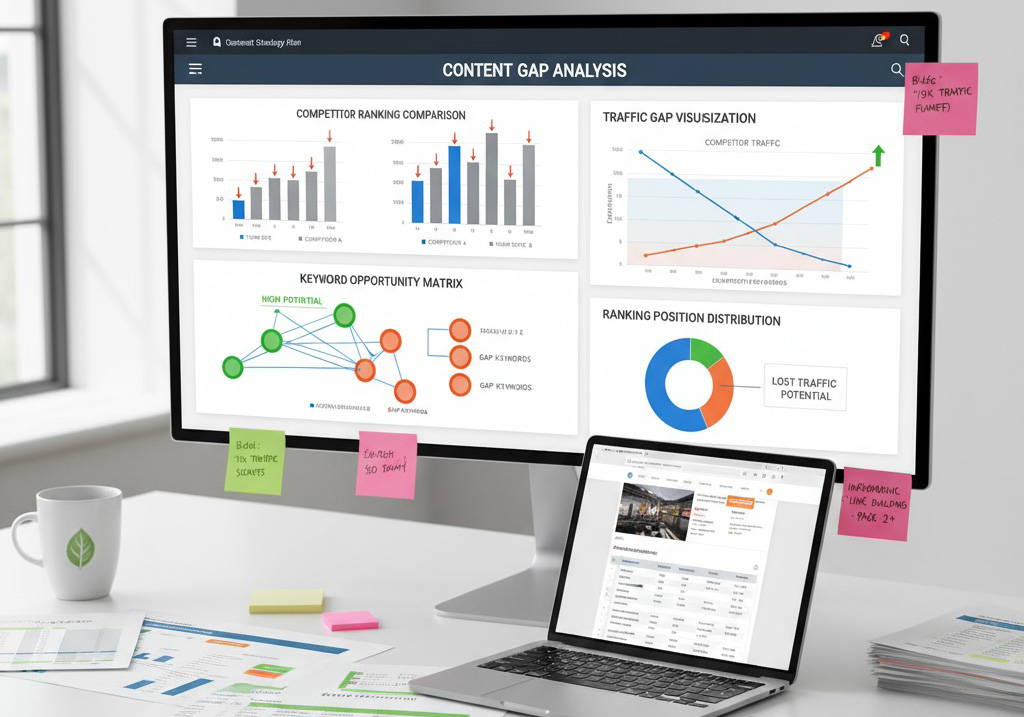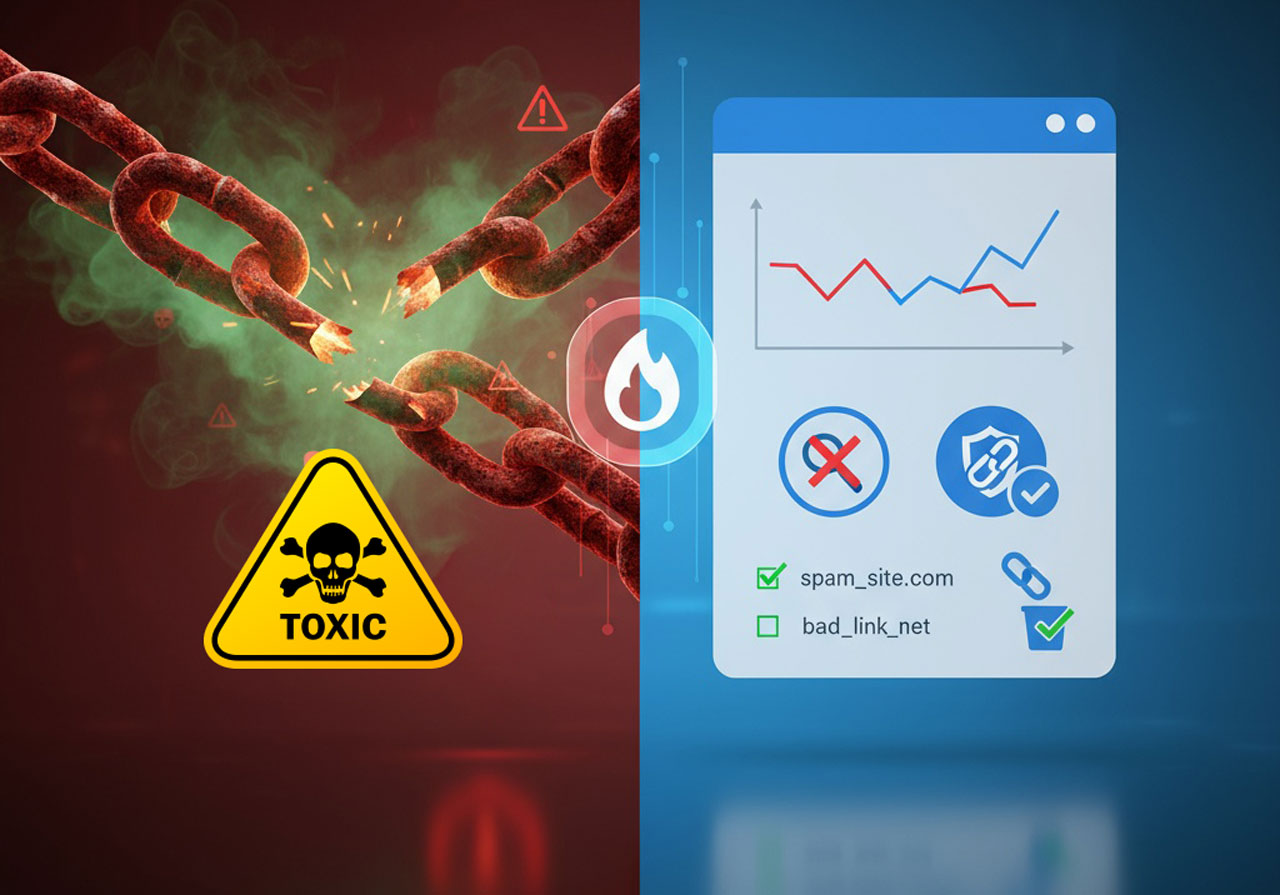Understanding where your content strategy falls short is crucial for SEO success. A comprehensive content gap analysis reveals untapped keyword opportunities, competitor weaknesses, and content optimization potential that can dramatically improve your search engine rankings.
What Is Content Gap Analysis in SEO?
Content gap analysis is a strategic SEO process that identifies missing content opportunities by comparing your website’s content coverage against competitors and search demand. This analysis reveals keyword gaps, topic clusters you haven’t addressed, and content quality deficiencies that prevent higher search rankings.
The process encompasses three core components: competitor keyword analysis to find high-value keywords your competitors rank for, search intent mapping to identify unmet user needs, and content quality assessment to evaluate existing content for improvement opportunities.
Why Content Gap Analysis Drives SEO Results
Systematic content gap identification transforms your content marketing strategy from reactive to proactive, delivering measurable SEO improvements.
Revenue Impact: Companies conducting regular content gap analyses see 67% higher lead generation rates compared to those publishing content without strategic analysis.
Search Visibility Benefits: Addressing content gaps provides multiple ranking advantages including increased organic traffic through untapped keyword targeting, higher search rankings by covering topics more comprehensively than competitors, improved user engagement through content that directly addresses search intent, and enhanced domain authority via comprehensive topic coverage.
SEO Content Gap Analysis: 4-Step Process
Step 1: Identify Competitor Keywords and Ranking Gaps
Keyword gap analysis forms the foundation of effective content strategy. Focus on discovering high-value keywords where competitors outrank you.
Start with competitive keyword research using tools like SEMrush’s Keyword Gap or Ahrefs’ Content Gap. Input your domain alongside 3-4 direct competitors to reveal keyword opportunities.
Filtering for Quick Wins: Target keywords with search volume above 500 monthly searches, focus on long-tail keywords with lower competition (KD score below 30), and prioritize keywords where competitors rank in positions 1-10.
Advanced practitioners should examine semantic keyword clusters – groups of related terms that signal comprehensive topic coverage to search engines.
Step 2: Analyze Search Intent and User Behavior
Understanding what your audience actually searches for reveals content gaps that keyword tools might miss. User intent analysis uncovers the underlying motivations behind search queries.
Search Intent Categories:
- Informational intent – Users seeking knowledge or answers
- Commercial intent – Users researching purchase decisions
- Transactional intent – Users ready to convert or buy
- Navigational intent – Users looking for specific pages or brands
Research Methodologies include social listening to identify trending topics and pain points, customer survey analysis to understand information gaps, support ticket analysis to find commonly asked questions, and Google Search Console data to identify underperforming queries.
Step 3: Audit Underperforming Content for Optimization
Content performance analysis reveals existing pages with significant improvement potential. These represent the fastest path to ranking improvements.
Performance Indicators to monitor include declining organic traffic over 3-6 month periods, high bounce rates indicating content-user mismatch, low average session duration suggesting insufficient content depth, and poor conversion rates from organic traffic.
Google Search Console Analysis involves comparing performance across different time periods, identifying pages with decreasing click-through rates, finding queries where you rank on page 2-3 (positions 11-30), and discovering featured snippet opportunities where you rank highly but don’t own the snippet.
Step 4: Comprehensive SERP Analysis for Content Optimization
Search engine results page analysis reveals exactly what type of content Google rewards with top rankings. This intelligence guides content creation and optimization decisions.
SERP Features to Analyze:
- Featured snippets – Optimize for position zero opportunities
- People Also Ask boxes – Identify related questions to address
- Image and video results – Determine multimedia content needs
- Local pack results – Understand local SEO requirements
Content Quality Gaps commonly found in SERP analysis include outdated information from content published over 2 years ago, insufficient depth with superficial coverage of complex topics, missing expert insights lacking authoritative sources or quotes, poor user experience from slow loading or difficult navigation, and weak E-A-T signals with missing author credentials or expertise indicators.
Content Gap Analysis Tools for Maximum Efficiency
Professional SEO Tools:
- SEMrush Keyword Gap – Comprehensive competitor keyword analysis
- Ahrefs Content Gap – Detailed SERP feature analysis
- Moz Keyword Explorer – Search volume and difficulty data
- Screaming Frog – Technical content audit capabilities
Free Analysis Resources:
- Google Search Console – Performance data and search query insights
- Google Keyword Planner – Basic keyword research and volume data
- Answer The Public – Question-based keyword discovery
- Google Trends – Seasonal and trending topic identification
Content Strategy Implementation After Gap Analysis
Prioritization Framework for maximum SEO impact:
- High search volume, low competition keywords receive immediate attention
- Commercial intent keywords that align with business goals
- Topic clusters that can be comprehensively covered across multiple pages
- Quick win optimizations for existing content ranking on page 2-3
Content Creation Guidelines:
- Comprehensive topic coverage that exceeds competitor depth
- Expert insights and quotes to enhance E-A-T signals
- Multimedia integration including relevant images, videos, and infographics
- Internal linking strategy to distribute page authority across related content
Measuring Content Gap Analysis Success
Key Performance Indicators to track:
- Organic traffic growth to targeted pages
- Keyword ranking improvements for gap-targeted terms
- Featured snippet acquisitions for optimized content
- Conversion rate increases from organic search traffic
Tracking Tools and Frequency:
- Daily rank tracking for priority keywords
- Monthly traffic analysis via Google Analytics
- Quarterly comprehensive audits to identify new gaps
- Competitor monitoring for emerging content opportunities
Advanced Content Gap Analysis Techniques
Semantic SEO Integration: Modern content gap analysis must consider semantic search and natural language processing. Create content that addresses topic clusters rather than individual keywords.
Voice Search Optimization: With voice search growing rapidly, identify conversational keywords and question-based queries your content doesn’t address.
Technical SEO Alignment: Ensure content gap analysis includes page speed optimization, mobile responsiveness, and core web vitals improvements.
Content Freshness Strategy: Develop systems for content updates and republishing to maintain relevance and search visibility.
Content gap analysis is not a one-time activity but an ongoing SEO process that drives sustained organic growth. By systematically identifying and filling content gaps, you create a comprehensive content ecosystem that dominates search results and captures maximum organic traffic potential.
Regular analysis and implementation of these strategies will position your website as the authoritative resource in your industry, driving both immediate ranking improvements and long-term SEO success.













